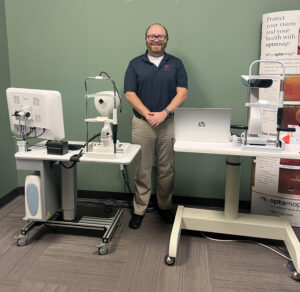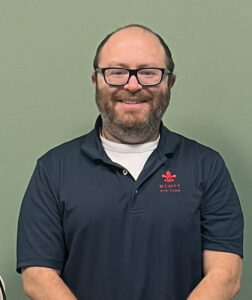
Dr. Cazares in his office’s pretesting room. Dr. Cazares says the strategic instrumentation investments he made helped him profitably launch his practice.
Investing in technology as a new practice to springboard care & profitability.
Part three of the Practice Launchpad series, curated by Erich H. Mattei, MBA, president of Akrinos. Each article will examine a different aspect of making a new practice a success. Click HERE to read the previous two articles in this series.
By Ryan Cazares, OD
Oct. 4, 2023
I started Scott Eye Care in my hometown of Scott, La., in June of 2013. My hometown had never had an eye doctor, despite a population of nearly 9,000 and being home to five schools. Only two years out of school, I took out a $210,000 SBA loan and started with one exam room, two staff–and no patients. Here are the key technology investments that allowed us to grow substantially since that time.
Strong Growth Trajectory
Our clinic has grown to two doctors (myself and an associate), eight support staff, four exam rooms, over 26,000 patient records and lots of equipment.
High-Quality Instrumentation Pays Off in Better Care & Nearly Immediate Higher Profitability
For a cold start such as mine, it is common to purchase old and used equipment. Think of it like comparing a 2001 Honda Civic to a 2023 Tesla Model 3. Both get you from A to B, right? So, why buy an autorefractor when you can use your retinoscope from school and the old hand-me-down keratometer from the retired OD that you used to tech for? Why buy an iCare tonometer when you have a Goldmann on your slit lamp?
Because, as your new clinic gets busier, time becomes invaluable. The time saved from using the autorefractor and iCare during your day booked with 19 patients allows you to add 2-3 more to your schedule. Your revenue increases $1,200 per day. This adds up very quickly!
Editor’s Note: There are other handheld tonometers to choose from. HERE are some of your other options.
Don’t be afraid of investing in new technology if it buys you time to spend on seeing more patients. It is a common mistake to not invest in technologies that do not have a direct insurance reimbursement. However, if that instrument saves you and your staff time and allows you to see more patients per day, it may be wise to invest in such technology–maybe even more so than one that can be billed to insurance!
What is the Most Important Technology to Streamline Workflows While Maintaining Superior Care?
An autorefractor is an essential investment for a new practice, as retinoscopy can slow things down, especially if the patient has small pupils or cataracts. I also believe a visual field is essential–not necessarily to streamline workflow, but to allow you to diagnose and treat serious conditions that only you as the patient’s eye doctor may be able to catch.
And, of course, you absolutely need to invest in electronic health records. It may be costly; however, the communication abilities it provides allow you to easily transfer care to and from your clinic. It makes it simple to refer a patient to a specialist or primary care provider. In return, those doctors can refer to you more easily. There is nothing more annoying than getting a referral from a doctor who still uses paper records and fax machines, as it can be difficult to decipher their findings. More time is wasted if you have to call said doctor’s office and ask for help to read their handwriting! An EHR can allow you to communicate with a fellow physician with the click of a button.
Other Articles to Explore
An autorefractor can cost around $3,000 used and upwards of $15,000 if it is new and has other features. You should definitely consider getting a used one or a basic one, as long as it estimates refractive error and performs keratometry.
A visual field instrument can cost around $3,000 used and more than $20,000 for a newer model. I would highly recommend splurging on a newer visual field of the virtual headset type. These visual fields have no footprint–you can bring them into your exam room and keep the extra space you’ve saved for an instrument you purchase after your clinic grows.
Imagine saving the space taken up by a Humphery visual field and later, as you grow, being able to house a cash-pay Optos, IPL device or Lipiflow! It can also be difficult to sell a larger visual field instrument when it comes time to upgrade, as most practices are moving to the virtual headset model.
An EHR monthly service fee will easily cost you $1,200 or more depending on how many of its features you currently use. The one we use has many add-ons, such as its intake services, billing services, direct messaging services and more. See if you can get by without many add-ons when you first open your clinic.
Track the ROI that Is Delivered
It is easy to measure if the investment has paid off. If your new instrument is billable to insurance, use your EHR’s metrics reporting system to figure out how much revenue you are collecting per month for the CPT code. Compare that to the amount of the monthly note. Is your revenue collected more than the note? If yes, you have made a wise investment. However, also consider that this technology may help you create more visits. For example, you may have had to refer out your glaucoma workups before your visual field and OCT purchases.
You also need to consider time. If you invest in technology that does not necessarily allows you to collect more revenue per exam, but allows you to see more patients per day, calculate how many patients you see per month prior to the purchase and compare it to how many patients you are seeing per month after the purchase. Multiply that number by your revenue per patient to figure out your monthly increase in revenue since your investment. Is the increase in revenue per month more than the note you are paying on the new technology? If yes, you have made a wise investment.
I have a goal of patients seen per month based on previous years. If we are not hitting that mark, I know that we are probably being too slow or not scheduling enough patients.
I also shadow my techs from time to time. Although it may be nerve-wracking for them, I find many small things they can do more efficiently. This is important to do, as when your staff turns over from time to time, the training becomes a game of telephone–each new technician is not trained to the same standard as the prior. It is your job to make sure training remains consistent through each year that passes.
Continue to Improve Via Technology Investment: Here’s What’s Next
Two technological investments I have made in the past couple of years are Weave and hiring a virtual assistant through Eye Help You. Our phone rings off the hook, so I knew I had to get rid of that distraction in order to get more out of my employees. My Eye Help You assistant answers most calls so that my front desk assistant can focus on greeting patients and directing their care appropriately, whether they are here for an annual exam, a scleral lens evaluation, an emergency, or simply to pick up glasses. Patients also enjoy Weave’s feature of being able to text with us. Weave also asks every single patient to rate our clinic after their visit. The result is a 5-star rating and over 600 reviews on Google.
Editor’s Note: Weave is one of many platforms you can choose from for patient communications. Other options include Solutionreach, Constant Contact and Demandforce, among other options.
Reducing excessive phone conversations and improving our online reputation with these technologies allows my staff to concentrate on the patients in front of them. Since implementing these technologies, my clinic has seen a $25 increase in revenue per patient. This may not seem like a lot; however, it equates to an increase in $118,000 in revenue per year!
Weave has an intra-office messaging system that allows the doctors and staff to easily communicate; however, sometimes testing orders for patients with eye disease get lost in the shuffle.
A colleague has recommended BlueNote, which I am currently looking into. This would allow the doctors and technicians to see what patients are in what exam rooms. It would also allow us to communicate to technicians what testing should be performed on a given patient, whether it be a visual field, topography or OCT. However, given the small size of my current location, I may pass on this investment until my plans to relocate and build come to fruition.
My OCT is out of date. It was my first big investment after opening cold. Although it still performs decently to help us track progression of glaucoma and find macular disease, it does not have a great anterior segment feature, which could help with some of those finicky scleral fits. However, the cost of a new OCT is astronomical when you compare that to its small reimbursement amount.
My most recent purchase was an Eaglet Scleral Lens Profiler. At $30,000, it was not a small investment; however, the result of using this technology is it cuts my scleral contact lens follow-ups in half since it provides an ideal fit. This allows me to schedule more new scleral fits instead of spending more chair time with established fits.
The next purchase I am going to make is a Firefly slit lamp. I currently have four old slit lamps, and one of them is on its deathbed. I have one exam room equipped with a Marco iON anterior segment imaging system; however, with my growing scleral patient base, and how cumbersome it can be to upload an image from the iON to our computer, I believe the Firefly would allow us to more easily take anterior segment photos, educate patients on meibomian gland dysfunction and send videos to my scleral lens labs.
 Ryan Cazares, OD, is the owner of Scott Eye Care in Scott, La. To contact him: dr.cazares@scotteye.com
Ryan Cazares, OD, is the owner of Scott Eye Care in Scott, La. To contact him: dr.cazares@scotteye.com

























